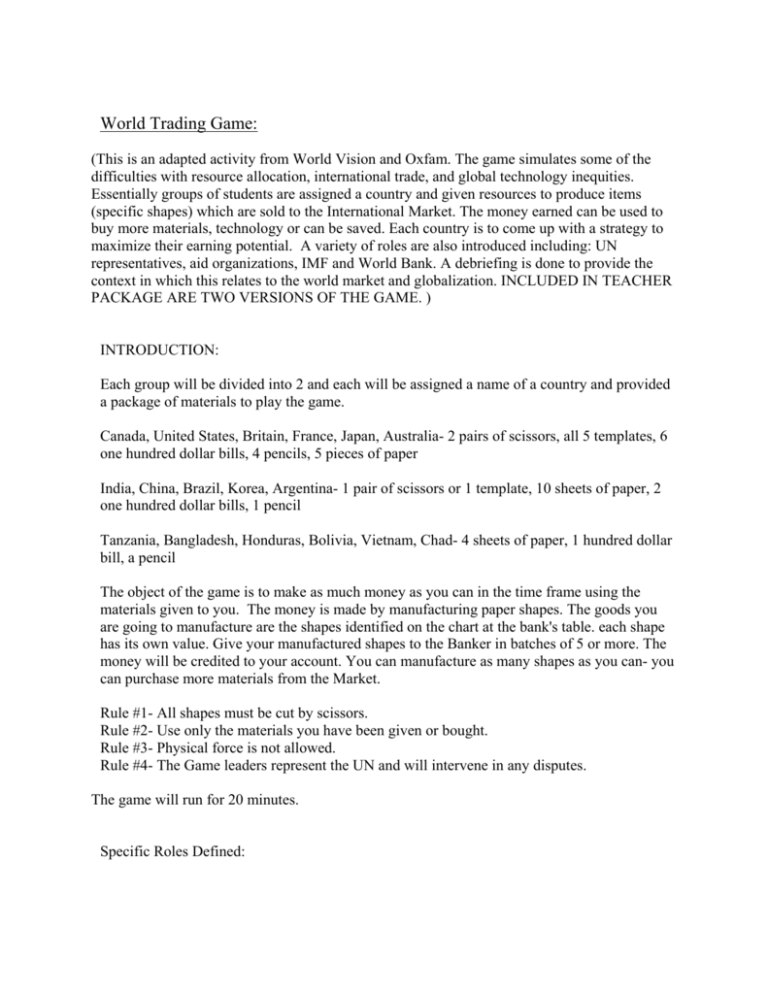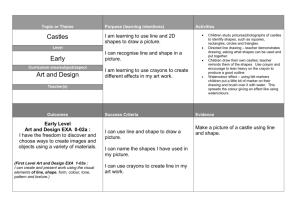World Trading Game - Developing a Global Perspective for Educators
advertisement

World Trading Game: (This is an adapted activity from World Vision and Oxfam. The game simulates some of the difficulties with resource allocation, international trade, and global technology inequities. Essentially groups of students are assigned a country and given resources to produce items (specific shapes) which are sold to the International Market. The money earned can be used to buy more materials, technology or can be saved. Each country is to come up with a strategy to maximize their earning potential. A variety of roles are also introduced including: UN representatives, aid organizations, IMF and World Bank. A debriefing is done to provide the context in which this relates to the world market and globalization. INCLUDED IN TEACHER PACKAGE ARE TWO VERSIONS OF THE GAME. ) INTRODUCTION: Each group will be divided into 2 and each will be assigned a name of a country and provided a package of materials to play the game. Canada, United States, Britain, France, Japan, Australia- 2 pairs of scissors, all 5 templates, 6 one hundred dollar bills, 4 pencils, 5 pieces of paper India, China, Brazil, Korea, Argentina- 1 pair of scissors or 1 template, 10 sheets of paper, 2 one hundred dollar bills, 1 pencil Tanzania, Bangladesh, Honduras, Bolivia, Vietnam, Chad- 4 sheets of paper, 1 hundred dollar bill, a pencil The object of the game is to make as much money as you can in the time frame using the materials given to you. The money is made by manufacturing paper shapes. The goods you are going to manufacture are the shapes identified on the chart at the bank's table. each shape has its own value. Give your manufactured shapes to the Banker in batches of 5 or more. The money will be credited to your account. You can manufacture as many shapes as you can- you can purchase more materials from the Market. Rule #1- All shapes must be cut by scissors. Rule #2- Use only the materials you have been given or bought. Rule #3- Physical force is not allowed. Rule #4- The Game leaders represent the UN and will intervene in any disputes. The game will run for 20 minutes. Specific Roles Defined: 1) IMF and World Bank- Keeps track of each county’s wealth on a chart, indicating the shapes manufactured by the countries. Determines any change in the value of the shapes due to force of the World Economy. 2) NGO Representatives- Provides extra resources to struggling countries in the way of technology or raw materials or consultation advice 3) UN Peacekeepers- Intervenes in any problem situations. Can provide sanctions to countries for disreputable practices. 4) Market- Collects and assesses the manufactured goods (checks quality control). Sells extra materials- pencils $10, scissors $100, templates varies, sheets of paper $25. GAME: Several interventions from specific roles can include: - IMF and World Bank- change prices of shapes twice during the game. Blow whistle to indicate change. Record on chart at the Market. Increase supply of raw material or material through NGo intervention to one or more countries Negotiate special deals will certain countries(ie: price of item goes up if a sticky note is attached to it) Record any alliances, deals, underhanded actions for the debrief. Keep track of grievances. DEBRIEF: The debrief is based on 3 questions: What I noticed, What I felt and What I learned. Remind everyone that this is a game and that we were all acting a role. Remind everyone that we must be respectful listeners and participants. - What did you notice? Did some countries have more to start with? Why is that? Is it fair? What strategy did you use to create wealth? What worked and what didn’t work? - How did it feel? If you were in one of the industrialized countries? Or newly industrialized country? Or one of the developing countries? How would cooperation have affected trading? - What did you learn? How is this linked to the world today? - Confirmation that all is forgiven and that all is fine- reminder that this was just a gameshake hands if needed







